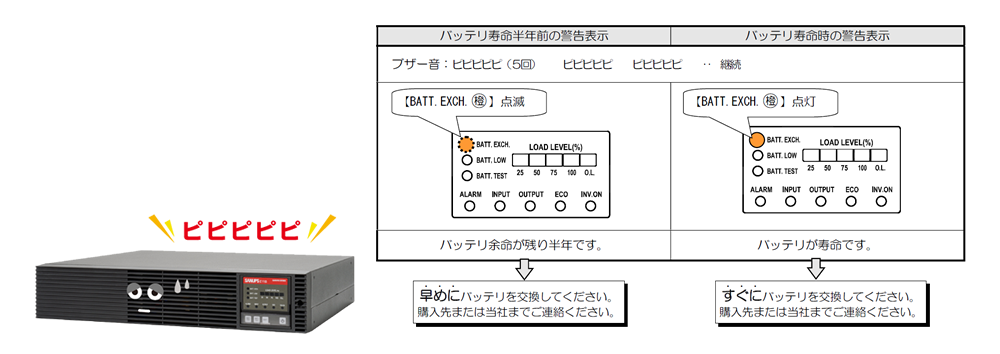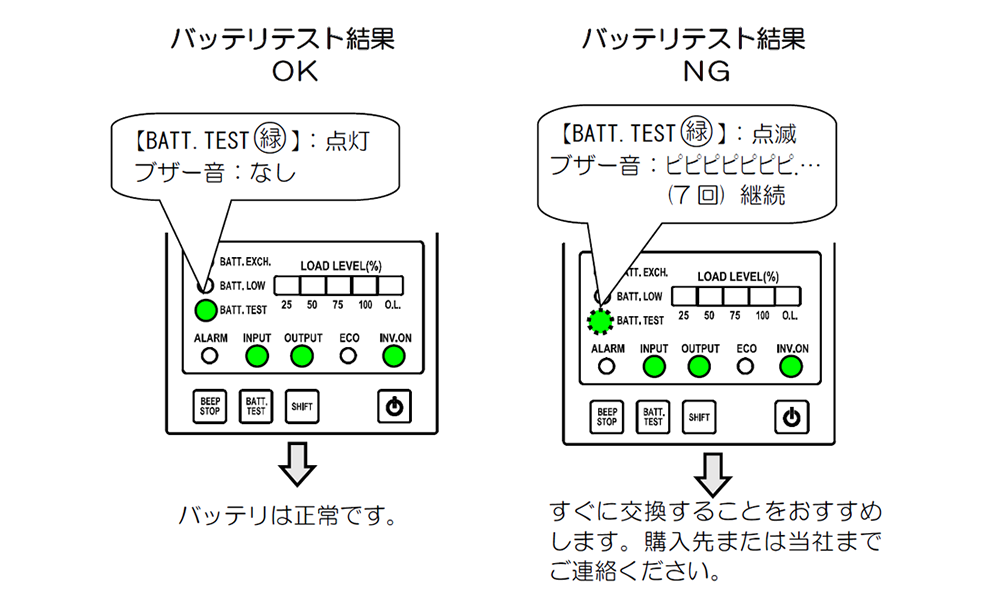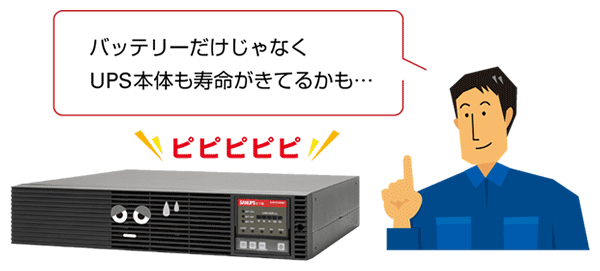



-
- Free Word Search




When it comes to UPS maintenance, battery replacement is probably the most regular task. However, there are actually many things you need to check, such as when and how to replace the battery, and what to do with the replaced battery.
In this article, we will introduce all the information you wanted to know in one place! When and how to replace the battery, how to dispose of it, and what alarms to use.
The battery life of a UPS varies depending on the surrounding usage environment, but it is generally said to be 2 to 5 years for lead-acid batteries and 10 years for lithium-ion batteries.
Details page: A thorough comparison of UPS lithium-ion batteries and lead-acid batteries!
Just because a battery has exceeded its lifespan does not mean that it will suddenly stop supplying electricity, so there may be cases where replacement is put off.
So what problems can occur if you don't replace a dead battery?
The storage capacity of a UPS battery gradually decreases over the years of use. In the case of lead-acid batteries, the battery's life is defined as the point at which its storage capacity is half that of a new battery. Since storage capacity is the backup time of the UPS, this means that the backup time of a UPS battery that has reached the end of its life is roughly half that of a new battery.
Normally, when selecting a UPS, the backup time at the end of the battery life is also taken into consideration, so this in itself is not a problem. However, if you continue to use a battery beyond its lifespan, the storage capacity will decrease in the short term, and in the event of a power outage or voltage drop, the expected backup capacity will not be secured, leading to risks such as data loss.
▼ Battery deterioration and backup time
Continuing to use a battery that has exceeded its lifespan without replacing it also poses physical risks. The Japan Electrical Manufacturers' Association (JEMA) warns against secondary damage such as battery leakage, strange odors, smoke, and fire.
Although batteries have an approximate lifespan, the actual time at which they reach the end of their life varies depending on the usage environment and ambient temperature.
So how do you tell if your battery is at the end of its life?
Many UPS models are configured to sound an alarm when the battery is at the end of its life.
As an example, let us look at the battery life warning display on our product "SANUPS E11B". As shown in the figure below, a lamp and buzzer sound will notify you when it is time to replace the battery. When the battery has only six months left to live, the lamp will "blink" orange, which means it is time to start preparing for a battery replacement. On the other hand, if the battery has already reached the end of its life, the lamp will "light up" orange. In this case, the battery needs to be replaced immediately. In either case, the buzzer will sound five repeated "beep beep beep" sounds to notify you.

If you have attached an "Installation Date/Battery Replacement Date Label" when you installed the UPS or replaced the battery the last time, check it. You can calculate the battery life from the installation date or replacement date and use this as a reference for when to replace the battery.

If the UPS has a battery test function, performing regular tests is also important for battery management. The battery test is a UPS function that tests whether power is normally supplied from the UPS battery to the connected load equipment.
For our product "SANUPS E11B", if you press and hold the BATT.TEST button, the green light will flash and the battery test will begin. If the green light is on and there is no beep, you can tell that the battery is supplying power normally. On the other hand, if the power supply is not normal, the green light will flash and the beep will sound seven times. In this case, you need to replace the battery immediately.

When it is time to replace the battery, we recommend that you check not only the battery life but also whether the equipment life has come to an end. The battery life of a typical lead-acid battery is 2 to 5 years. On the other hand, the life of the UPS unit is 5 to 15 years, so the first or second battery replacement alarm may be a sign that the equipment life has also come to an end.
When replacing the batteries, be sure to check the lifespan of the UPS itself.

When it's time to replace the battery, how do you do it and how do you dispose of the old battery?
While this varies by manufacturer, in our case, there are some models of small-capacity UPS that allow customers to easily replace the battery themselves.
As an example, we will introduce how to replace the battery in our product, SANUPS E11B *1.
*1 Replacement methods vary depending on the model. Be sure to check the operating procedures for each product.
For products that comply with overseas standards such as UL/CE, please contact the manufacturer for a battery replacement due to standard restrictions.
For some of our small capacity UPS and medium to large capacity UPS, customers cannot replace the battery themselves. In such cases, please contact the dealer or agent from whom you purchased the UPS, or contact us.
When it is time to replace the battery, we recommend that you check not only the battery life but also whether the equipment life has come to an end. The battery life of a typical lead-acid battery is 2 to 5 years. On the other hand, the life of the UPS unit is 5 to 15 years, so the first or second battery replacement alarm may be a sign that the equipment life has also come to an end.
When replacing the batteries, be sure to check the lifespan of the UPS itself.

This document summarizes the information and overview required when selecting a UPS.
Please download it and use it!
The food processing factory where Mr. H works has installed a UPS to back up the automatic labeler. The UPS had been installed for nearly 10 years, but it had been operating smoothly without any malfunctions.
One day, the UPS alarm went off. After investigating, I found out that it was a warning that it was time to replace the battery. Although I felt the need to replace it, I thought to myself, "It's not like the battery in your smartphone will suddenly stop working one day. I can just do it when I'm doing maintenance on my other devices," and put off replacing the battery.
One day in March, Mr. H was working at the factory as usual when suddenly there was a power outage. We later found out the cause was that a tree near the factory had fallen due to strong winds that day, causing the electric wires to come into contact with each other, which caused the power outage.
"The power outage continued for a while, but we had generators ready, so a power outage of a certain duration shouldn't have affected factory operations. However, the UPS, which was supposed to provide power until the generators could supply electricity, did not provide backup for the expected amount of time," Mr. H continued, looking back on that time.
"The expected backup time was about one minute until power was supplied from the generator. However, because the battery replacement was not done at the appropriate time, the power supply was cut off about halfway through the time. This resulted in some lots not being properly labeled, and it was extremely difficult to recover them manually."
Later, when the batteries were replaced, it was discovered that the UPS itself would also reach the end of its life in about six months. Taking maintenance costs into consideration, Mr. H's factory decided to replace the UPS itself. "We take great care to manage both the batteries and the UPS so that the factory can operate with peace of mind," said Mr. H.
Supervisor: Dr. Kiyotaka Izumiya, Senior Technical Advisor, Sales Department SANYO DENKI CO., LTD.
Update date: /release date: